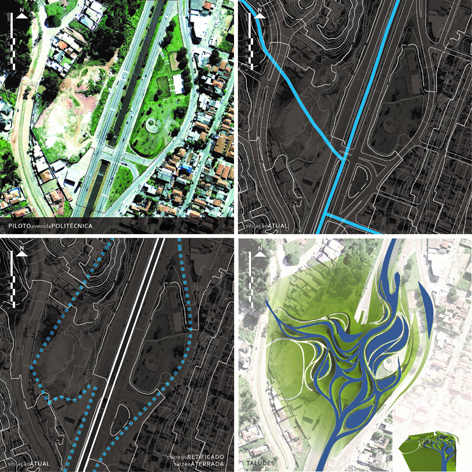
Intelligent Landscapes: Application of Parametric Modeling for a New Generation of Flood Risk Management Reservoirs in São Paulo City, Brazil
Abstract
A retention facility is presented as a prototype evaluated not only for its volume capacity but also for its performance as a water landscape and a Stormwater Best Management Practice. Computer aided parametric modeling, using CAD software Rhinoceros© and its algorithmic modeling plugin, Grasshopper, offered new ways of investigating performance combined with design. This functionality allowed a greater freedom of design, which returns to the water landscapes of the anastomosed rivers, adapted to the dynamics of the different water flows, slowness and phytoremediation. This experiment has demonstrated the capacity of the parametric model to calculate the retention volume, as well as to represent the new 3D morphology, reaching a prospective language for landscape architecture in balance with hydraulic engineering requirements.
Keywords
Full Text:
PDFReferences
Benedict, M. A. & McMahon, E. T. (2006). Green infrastructure: Linking landscapes and communities. Washington, DC.: Island Press.
Bonzi, R. S. (2017). Paisagem como Infraestrutura. In Pellegrino, P. & Moura, N. (Eds). Estratégias para uma Infraestrutura Verde. (pp1-24) Barueri, SP: Manole.
Cantrell, B & Holzman, J (2016). Responsive landscapes: strategies for responsive technologies in landscape architecture. New York, Routledge.
Davis, D. (2013). Modelled on Software Engineering: Flexible Parametric Models in the Practice of Architecture. PhD Thesis. Melbourne: RMIT University.
Dresch, A; Lacerda, D. & Antunes Jr., J (2015) Design Science Research: A Method for Science and Technology Advancement. London: Springer. ISBN 978-3-319-07374-3.
Gianneti, C. (2006). Estética Digital: Sintopia da Arte, a Ciência e a Tecnologia. Belo Horizonte: C/Arte.
Instituto Brasileiro de Geografia e Estatística-IBGE (2010). Censo Demográfico 2010. Rio de Janeiro: Instituto Brasileiro de Geografia e Estatística.
Moura, N.; Pellegrino, P; Martins, J. & Rizzi, D. (2015). Evaluation of bioretention as a best management practice for nonpoint-source pollution mitigation. In ICUD 20017 - Proceedings and Presentations. Retrieved from http://www.icud2017.org/ on 2018-04-02.
Moura, N; Pellegrino, P & Martins, J (2017). The Jaguaré Creek Revitalization Project: Transforming São Paulo through a Green Stormwater Infrastructure. PROCEDIA ENGINEERING, v.198, p.894 - 906. https://doi.org/10.1016/j.proeng.2017.07.165.
Novotny, V.; Ahern, J. & Brown, P. (2010). Water Centric Sustainable Communities: planning, retrofitting, and building the next urban environment. New Jersey: John Wiley Inc..
PMSP & FCTH (2017). Cadernos de Bacias Hidrográficas. Retrieved from http://www.prefeitura.sp.gov.br/cidade/secretarias/obras/obras_de_drenagem/index.php?p=230496 on 2018-04-08
Terzidis, K. (2004). Algorithmic Design: a Paradigm Shift in Architecture? In Architecture in the Network Society: 22nd eCAADe Conference Proceedings (pp201-207). Copenhagen, Denmark: Royal Danish Academy of Fine Arts.
Vieira, J. (2008). Teoria do Conhecimento e Arte. Fortaleza: Expressão Gráfica e Editora (2nd Ed.).
Woodbury, R. (2010). Elements of Parametric Design. Oxon: Routledge.
Refbacks
- There are currently no refbacks.
Copyright (c) 2018 Newton Celio Becker Moura, Paulo Pellegrino, Rodolfo Scarati, Bruno Raviolo, Eugênio Moreira
DISEGNARECON
ISSN 1828 5961
Registration at L'Aquila Law Court no 3/15 on 29th June, 2015.
Indexed in SCOPUS. Diamond Open Access. All papers are subjected to double blind peer review process by qualified reviewers.
Journal founded by Roberto Mingucci
